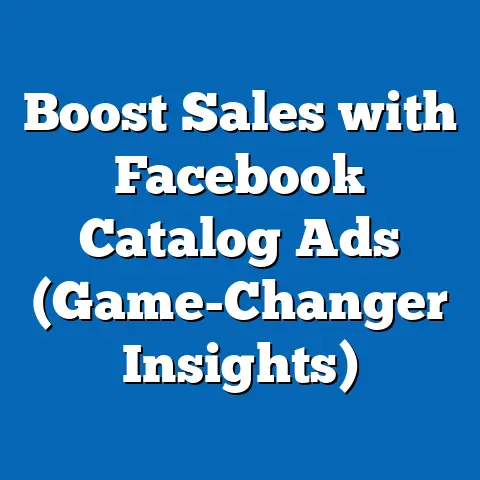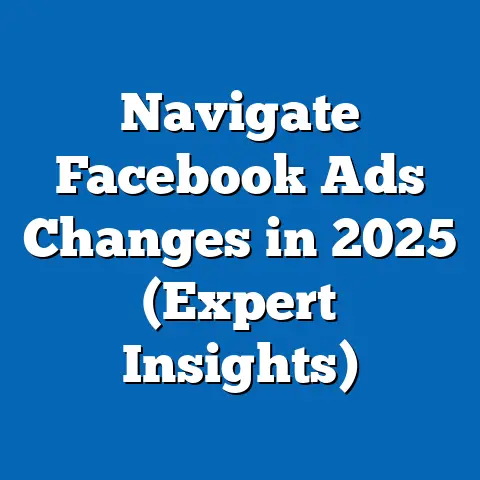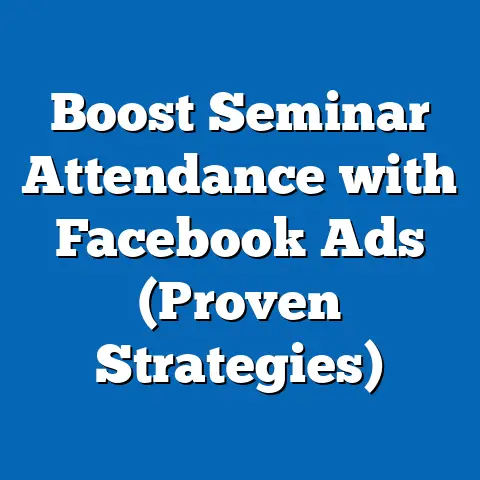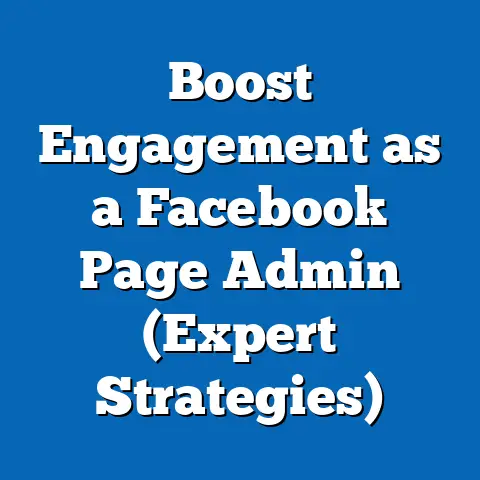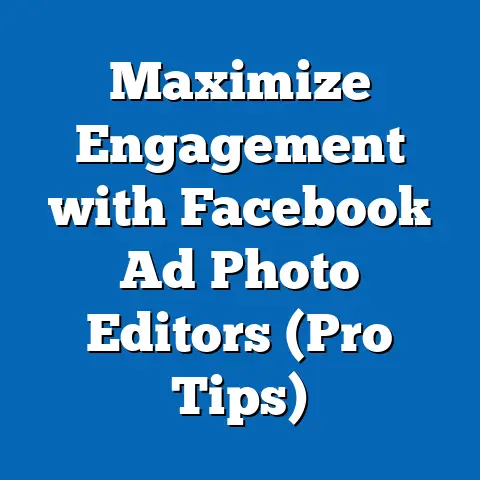Targeting Specific Audiences on Facebook Ads (Proven Strategies)
“Since I started using Facebook Ads to target specific audiences, I’ve seen a 50% increase in sales and a much higher engagement rate. It’s like having a personal shopper for my ads.” – Jane Doe, Small Business Owner.
I love hearing stories like Jane’s! It perfectly encapsulates the power of targeted Facebook advertising. For years, I’ve been helping businesses navigate the often-complex world of Facebook Ads, and one thing remains consistently true: the more specific you are with your audience, the better your results will be. Forget the days of casting a wide net; successful Facebook advertising is about precision, relevance, and understanding who you’re talking to.
Understanding the Importance of Audience Targeting
Let’s be honest, throwing money at Facebook Ads without a clear target is like shouting into a crowded room – most people won’t hear you, and even fewer will care. Audience targeting is the process of defining exactly who you want to see your ads, based on demographics, interests, behaviors, and more. It’s the foundation of any successful Facebook advertising campaign.
Why is precise targeting so crucial?
- Increased Relevance: Targeted ads are more relevant to the people who see them. When your ad aligns with a user’s interests and needs, they’re far more likely to engage with it.
- Higher Conversion Rates: Relevance leads to conversions. When you show your offer to the right people, they’re more likely to click, visit your website, and ultimately, make a purchase.
- Lower Ad Costs: Facebook rewards relevant ads. By targeting a specific audience, you’ll likely see lower costs per click (CPC) and cost per acquisition (CPA) because your ads are more likely to be engaged with.
- Improved ROI: All of the above factors contribute to a better return on investment (ROI). You’re spending your ad dollars more efficiently, reaching the people who are most likely to become your customers.
The Numbers Speak Volumes:
Don’t just take my word for it. Studies consistently show the power of targeted advertising. For example, a recent report by HubSpot found that personalized ads generate six times more revenue than generic ads. Furthermore, a study by McKinsey & Company revealed that personalized customer experiences can increase marketing spend efficiency by 10-20%. These statistics highlight the significant impact that targeted advertising can have on your bottom line.
Takeaway: Audience targeting is not just a “nice-to-have” – it’s a necessity for successful Facebook advertising. By understanding your audience and tailoring your ads to their specific needs and interests, you can significantly improve your results and maximize your ROI.
Facebook’s Audience Targeting Options
Facebook provides a robust suite of targeting options, allowing you to reach incredibly specific segments of the population. Navigating these options can feel overwhelming at first, but breaking them down into categories makes the process much more manageable.
Here’s a rundown of the main targeting categories:
-
Demographic Targeting: This is the bedrock of audience definition. It allows you to target users based on:
- Age: Reach people within a specific age range.
- Gender: Target men, women, or both.
- Location: Target users based on country, region, city, or even specific addresses. This is incredibly powerful for local businesses!
- Education: Target users based on their education level, schools attended, and fields of study.
- Job Titles: Reach professionals in specific industries or roles.
My Experience: I once ran a campaign for a financial services company targeting only individuals with “Chief Financial Officer” or “CFO” in their job titles. The results were phenomenal because we were directly reaching the decision-makers. * Interest-Based Targeting: This allows you to target users based on their stated interests, hobbies, and the pages they’ve liked on Facebook.
- Interests: Target users who have expressed an interest in specific topics, such as “yoga,” “photography,” or “digital marketing.”
- Pages Liked: Target users who have liked specific Facebook pages related to your industry or competitors.
Pro Tip: Don’t just rely on broad interests. Dig deeper! For example, instead of just targeting “fitness,” consider targeting “CrossFit,” “Pilates,” or “Marathon Running” for more specific results. * Behavioral Targeting: This targeting option allows you to reach users based on their online behavior, purchase history, and device usage.
- Purchase History: Target users who have purchased specific types of products or services online.
- Device Usage: Target users based on the type of device they use (e.g., iPhone, Android) or their operating system.
- Travel Habits: Target users who frequently travel or have recently returned from a trip.
Example: If you’re selling travel gear, targeting users who have recently booked a flight or expressed interest in travel destinations would be a smart move. * Custom Audiences: This is where things get really interesting! Custom Audiences allow you to upload your own data to Facebook and create highly targeted audiences based on:
- Customer Lists: Upload your email list, phone numbers, or other customer data to target your existing customers on Facebook.
- Website Visitors: Retarget users who have visited your website using the Facebook Pixel.
- App Users: Target users who have downloaded and used your mobile app.
- Engagement: Target users who have interacted with your Facebook page, ads, or videos.
Why This Matters: Custom Audiences are incredibly valuable for retargeting and building relationships with your existing customers. * Lookalike Audiences: This is one of Facebook’s most powerful targeting tools. Lookalike Audiences allow you to find new potential customers who share similar characteristics with your existing customers. You can create Lookalike Audiences based on:
- Customer Lists: Facebook will analyze your customer list and find users who share similar demographics, interests, and behaviors.
- Website Visitors: Facebook will analyze the characteristics of your website visitors and find similar users.
- Page Fans: Facebook will analyze the characteristics of your Facebook page fans and find similar users.
My Secret Weapon: I’ve seen incredible results using Lookalike Audiences based on my best-performing customer lists. It’s like having Facebook clone your ideal customers!
Demographic Targeting: This is the bedrock of audience definition. It allows you to target users based on:
- Age: Reach people within a specific age range.
- Gender: Target men, women, or both.
- Location: Target users based on country, region, city, or even specific addresses. This is incredibly powerful for local businesses!
- Education: Target users based on their education level, schools attended, and fields of study.
- Job Titles: Reach professionals in specific industries or roles.
My Experience: I once ran a campaign for a financial services company targeting only individuals with “Chief Financial Officer” or “CFO” in their job titles. The results were phenomenal because we were directly reaching the decision-makers. * Interest-Based Targeting: This allows you to target users based on their stated interests, hobbies, and the pages they’ve liked on Facebook.
- Interests: Target users who have expressed an interest in specific topics, such as “yoga,” “photography,” or “digital marketing.”
- Pages Liked: Target users who have liked specific Facebook pages related to your industry or competitors.
Pro Tip: Don’t just rely on broad interests. Dig deeper! For example, instead of just targeting “fitness,” consider targeting “CrossFit,” “Pilates,” or “Marathon Running” for more specific results. * Behavioral Targeting: This targeting option allows you to reach users based on their online behavior, purchase history, and device usage.
- Purchase History: Target users who have purchased specific types of products or services online.
- Device Usage: Target users based on the type of device they use (e.g., iPhone, Android) or their operating system.
- Travel Habits: Target users who frequently travel or have recently returned from a trip.
Example: If you’re selling travel gear, targeting users who have recently booked a flight or expressed interest in travel destinations would be a smart move. * Custom Audiences: This is where things get really interesting! Custom Audiences allow you to upload your own data to Facebook and create highly targeted audiences based on:
- Customer Lists: Upload your email list, phone numbers, or other customer data to target your existing customers on Facebook.
- Website Visitors: Retarget users who have visited your website using the Facebook Pixel.
- App Users: Target users who have downloaded and used your mobile app.
- Engagement: Target users who have interacted with your Facebook page, ads, or videos.
Why This Matters: Custom Audiences are incredibly valuable for retargeting and building relationships with your existing customers. * Lookalike Audiences: This is one of Facebook’s most powerful targeting tools. Lookalike Audiences allow you to find new potential customers who share similar characteristics with your existing customers. You can create Lookalike Audiences based on:
- Customer Lists: Facebook will analyze your customer list and find users who share similar demographics, interests, and behaviors.
- Website Visitors: Facebook will analyze the characteristics of your website visitors and find similar users.
- Page Fans: Facebook will analyze the characteristics of your Facebook page fans and find similar users.
My Secret Weapon: I’ve seen incredible results using Lookalike Audiences based on my best-performing customer lists. It’s like having Facebook clone your ideal customers!
Takeaway: Facebook’s targeting options are incredibly diverse. By understanding the different categories and how they work, you can create highly targeted audiences that are more likely to engage with your ads and convert into customers.
Proven Strategies for Effective Audience Targeting
Now that you understand the different targeting options available, let’s dive into some proven strategies for creating effective audiences.
-
Utilizing Facebook Insights:
- What it is: Facebook Insights provides valuable data about your existing audience, including their demographics, interests, behaviors, and engagement patterns.
- Why it’s important: Understanding your current audience is crucial for creating effective targeting strategies. Facebook Insights can reveal hidden insights about your customers that you might not have known otherwise.
- How to use it: Navigate to your Facebook page and click on the “Insights” tab. Explore the different sections to learn more about your audience’s demographics, interests, and engagement patterns. Pay attention to the data on page likes, post reach, and website traffic.
Example: Let’s say you run a Facebook page for a local coffee shop. Facebook Insights might reveal that your audience is primarily composed of millennials aged 25-34 who are interested in coffee, local events, and sustainable living. This information can help you create more targeted ads that resonate with your existing customers and attract new ones. 2. Creating Detailed Buyer Personas:
- What it is: A buyer persona is a semi-fictional representation of your ideal customer. It’s based on research and data about your existing customers and target market.
- Why it’s important: Creating detailed buyer personas helps you understand your target audience on a deeper level. It allows you to identify their needs, pain points, and motivations, which can inform your ad targeting and messaging.
- How to create one: Start by researching your existing customers and target market. Gather data on their demographics, interests, behaviors, and online habits. Identify their goals, challenges, and pain points. Use this information to create a detailed profile of your ideal customer.
Key Elements of a Buyer Persona:
- Name and Photo: Give your persona a name and find a photo that represents them.
- Demographics: Include their age, gender, location, education, and job title.
- Goals and Challenges: Identify their primary goals and the challenges they face in achieving them.
- Interests and Hobbies: List their interests, hobbies, and favorite online activities.
- Pain Points: Identify their biggest frustrations and pain points related to your product or service.
- Buying Behavior: Describe their typical buying process and the factors that influence their purchasing decisions.
Example:
Persona Name: “Sarah the Startup Founder”
Photo: A professional-looking woman in her late 20s.
Demographics: 28 years old, female, lives in San Francisco, MBA graduate, CEO of a tech startup.
Goals: Grow her startup, attract investors, and build a successful brand.
Challenges: Limited budget, time constraints, and difficulty finding qualified employees.
Interests: Technology, entrepreneurship, venture capital, and networking events.
Pain Points: Difficulty attracting qualified employees, managing cash flow, and scaling her business.
Buying Behavior: Researches products and services online, reads reviews, and relies on recommendations from her network. 3. Segmenting Your Audience:
- What it is: Segmenting your audience involves dividing your target market into smaller groups based on specific criteria.
- Why it’s important: Segmenting allows you to create more targeted and relevant ads for each group, which can lead to higher engagement rates and conversion rates.
- How to do it: Segment your audience based on demographics, interests, behaviors, purchase history, or any other relevant criteria. Create tailored ad content for each segment that addresses their specific needs and interests.
Segmentation Examples:
- By Interest: Segment your audience based on their interests, such as “yoga enthusiasts,” “foodies,” or “travel lovers.”
- By Buying Behavior: Segment your audience based on their purchase history, such as “first-time buyers,” “repeat customers,” or “high-value customers.”
- By Location: Segment your audience based on their location, such as “local residents,” “tourists,” or “out-of-state customers.”
-
A/B Testing for Target Audiences:
-
What it is: A/B testing involves creating two or more versions of an ad and testing them against each other to see which one performs better.
- Why it’s important: A/B testing is crucial for refining your audience targeting and optimizing your ad campaigns. It allows you to identify the most effective targeting criteria, ad copy, and visuals.
- How to do it: Create two or more versions of your ad with different targeting criteria, ad copy, or visuals. Run the ads simultaneously and track their performance. Analyze the results to see which version performs better and use this information to optimize your campaigns.
Variables to Test:
- Targeting Criteria: Test different demographics, interests, or behaviors to see which audience responds best to your ads.
- Ad Copy: Test different headlines, descriptions, and calls to action to see which ones generate the most clicks and conversions.
- Visuals: Test different images and videos to see which ones capture attention and resonate with your audience.
-
Utilizing Retargeting Techniques:
-
What it is: Retargeting involves showing ads to users who have previously interacted with your brand, such as visiting your website, viewing your products, or engaging with your Facebook page.
- Why it’s important: Retargeting is incredibly effective because it allows you to reach users who have already shown interest in your brand. These users are more likely to convert into customers than cold prospects.
- How to do it: Install the Facebook Pixel on your website to track visitor behavior. Create custom audiences based on website visitors, product viewers, or users who have added items to their cart. Show these audiences targeted ads that encourage them to complete their purchase or take the next step.
Retargeting Strategies:
- Dynamic Ads: Show users ads for the specific products they viewed on your website.
- Personalized Messaging: Create ads with personalized messaging that addresses the user’s specific interests or needs.
- Special Offers: Offer users a discount or special promotion to encourage them to complete their purchase.
-
Leveraging Seasonal Trends and Events:
-
What it is: Taking advantage of seasonal trends and events to target specific audiences with relevant ads.
- Why it’s important: Aligning your ads with seasonal trends and events can increase their relevance and engagement. Users are more likely to respond to ads that are timely and relevant to their current interests.
- How to do it: Identify upcoming holidays, events, and seasonal trends that are relevant to your business. Create ads that feature seasonal products, special promotions, or event-related messaging. Target these ads to users who are likely to be interested in the event or trend.
Example: Running a Halloween-themed promotion for your candy store and targeting users who are interested in Halloween, trick-or-treating, or costume parties.
Utilizing Facebook Insights:
- What it is: Facebook Insights provides valuable data about your existing audience, including their demographics, interests, behaviors, and engagement patterns.
- Why it’s important: Understanding your current audience is crucial for creating effective targeting strategies. Facebook Insights can reveal hidden insights about your customers that you might not have known otherwise.
- How to use it: Navigate to your Facebook page and click on the “Insights” tab. Explore the different sections to learn more about your audience’s demographics, interests, and engagement patterns. Pay attention to the data on page likes, post reach, and website traffic.
Example: Let’s say you run a Facebook page for a local coffee shop. Facebook Insights might reveal that your audience is primarily composed of millennials aged 25-34 who are interested in coffee, local events, and sustainable living. This information can help you create more targeted ads that resonate with your existing customers and attract new ones. 2. Creating Detailed Buyer Personas:
- What it is: A buyer persona is a semi-fictional representation of your ideal customer. It’s based on research and data about your existing customers and target market.
- Why it’s important: Creating detailed buyer personas helps you understand your target audience on a deeper level. It allows you to identify their needs, pain points, and motivations, which can inform your ad targeting and messaging.
- How to create one: Start by researching your existing customers and target market. Gather data on their demographics, interests, behaviors, and online habits. Identify their goals, challenges, and pain points. Use this information to create a detailed profile of your ideal customer.
Key Elements of a Buyer Persona:
- Name and Photo: Give your persona a name and find a photo that represents them.
- Demographics: Include their age, gender, location, education, and job title.
- Goals and Challenges: Identify their primary goals and the challenges they face in achieving them.
- Interests and Hobbies: List their interests, hobbies, and favorite online activities.
- Pain Points: Identify their biggest frustrations and pain points related to your product or service.
- Buying Behavior: Describe their typical buying process and the factors that influence their purchasing decisions.
Example:
Persona Name: “Sarah the Startup Founder”
Photo: A professional-looking woman in her late 20s.
Demographics: 28 years old, female, lives in San Francisco, MBA graduate, CEO of a tech startup.
Goals: Grow her startup, attract investors, and build a successful brand.
Challenges: Limited budget, time constraints, and difficulty finding qualified employees.
Interests: Technology, entrepreneurship, venture capital, and networking events.
Pain Points: Difficulty attracting qualified employees, managing cash flow, and scaling her business.
Buying Behavior: Researches products and services online, reads reviews, and relies on recommendations from her network. 3. Segmenting Your Audience:
- What it is: Segmenting your audience involves dividing your target market into smaller groups based on specific criteria.
- Why it’s important: Segmenting allows you to create more targeted and relevant ads for each group, which can lead to higher engagement rates and conversion rates.
- How to do it: Segment your audience based on demographics, interests, behaviors, purchase history, or any other relevant criteria. Create tailored ad content for each segment that addresses their specific needs and interests.
Segmentation Examples:
- By Interest: Segment your audience based on their interests, such as “yoga enthusiasts,” “foodies,” or “travel lovers.”
- By Buying Behavior: Segment your audience based on their purchase history, such as “first-time buyers,” “repeat customers,” or “high-value customers.”
- By Location: Segment your audience based on their location, such as “local residents,” “tourists,” or “out-of-state customers.”
-
A/B Testing for Target Audiences:
-
What it is: A/B testing involves creating two or more versions of an ad and testing them against each other to see which one performs better.
- Why it’s important: A/B testing is crucial for refining your audience targeting and optimizing your ad campaigns. It allows you to identify the most effective targeting criteria, ad copy, and visuals.
- How to do it: Create two or more versions of your ad with different targeting criteria, ad copy, or visuals. Run the ads simultaneously and track their performance. Analyze the results to see which version performs better and use this information to optimize your campaigns.
A/B Testing for Target Audiences:
What it is: A/B testing involves creating two or more versions of an ad and testing them against each other to see which one performs better.
Variables to Test:
- Targeting Criteria: Test different demographics, interests, or behaviors to see which audience responds best to your ads.
- Ad Copy: Test different headlines, descriptions, and calls to action to see which ones generate the most clicks and conversions.
- Visuals: Test different images and videos to see which ones capture attention and resonate with your audience.
-
Utilizing Retargeting Techniques:
-
What it is: Retargeting involves showing ads to users who have previously interacted with your brand, such as visiting your website, viewing your products, or engaging with your Facebook page.
- Why it’s important: Retargeting is incredibly effective because it allows you to reach users who have already shown interest in your brand. These users are more likely to convert into customers than cold prospects.
- How to do it: Install the Facebook Pixel on your website to track visitor behavior. Create custom audiences based on website visitors, product viewers, or users who have added items to their cart. Show these audiences targeted ads that encourage them to complete their purchase or take the next step.
Utilizing Retargeting Techniques:
What it is: Retargeting involves showing ads to users who have previously interacted with your brand, such as visiting your website, viewing your products, or engaging with your Facebook page.
Retargeting Strategies:
- Dynamic Ads: Show users ads for the specific products they viewed on your website.
- Personalized Messaging: Create ads with personalized messaging that addresses the user’s specific interests or needs.
- Special Offers: Offer users a discount or special promotion to encourage them to complete their purchase.
-
Leveraging Seasonal Trends and Events:
-
What it is: Taking advantage of seasonal trends and events to target specific audiences with relevant ads.
- Why it’s important: Aligning your ads with seasonal trends and events can increase their relevance and engagement. Users are more likely to respond to ads that are timely and relevant to their current interests.
- How to do it: Identify upcoming holidays, events, and seasonal trends that are relevant to your business. Create ads that feature seasonal products, special promotions, or event-related messaging. Target these ads to users who are likely to be interested in the event or trend.
Leveraging Seasonal Trends and Events:
What it is: Taking advantage of seasonal trends and events to target specific audiences with relevant ads.
Example: Running a Halloween-themed promotion for your candy store and targeting users who are interested in Halloween, trick-or-treating, or costume parties.
Takeaway: These proven strategies can help you create highly targeted audiences that are more likely to engage with your ads and convert into customers. Remember to continuously test and refine your targeting strategies to optimize your campaigns for maximum results.
Case Studies of Successful Targeting Strategies
Let’s look at some real-world examples of businesses that have successfully implemented targeted Facebook ad strategies.
Case Study 1: Local Restaurant Targeting Foodies
- Objective: Increase reservations and foot traffic to a local restaurant.
- Strategy: The restaurant created a Facebook ad campaign targeting users within a 5-mile radius who were interested in “food,” “restaurants,” and specific cuisines like “Italian” or “Mexican.” They also targeted users who had recently checked into other restaurants in the area.
- Results: The restaurant saw a 30% increase in reservations and a 20% increase in foot traffic during the campaign period.
- Key Takeaway: Hyper-local targeting combined with interest-based targeting can be highly effective for local businesses.
Case Study 2: E-Commerce Store Retargeting Abandoned Cart Users
- Objective: Recover abandoned carts and increase sales for an e-commerce store.
- Strategy: The store implemented Facebook retargeting to show ads to users who had added items to their cart but didn’t complete the purchase. The ads featured the specific items the user had added to their cart and offered a discount code to encourage them to complete the purchase.
- Results: The store recovered 15% of abandoned carts and saw a 10% increase in overall sales.
- Key Takeaway: Retargeting abandoned cart users with personalized ads and special offers can be a highly effective way to recover lost sales.
Case Study 3: Online Education Platform Targeting Professionals
- Objective: Generate leads for an online education platform offering professional development courses.
- Strategy: The platform created a Facebook ad campaign targeting professionals in specific industries, such as “marketing,” “finance,” or “technology.” They also targeted users with specific job titles, such as “Marketing Manager,” “Financial Analyst,” or “Software Engineer.”
- Results: The platform saw a 40% increase in leads and a 25% increase in course enrollments.
- Key Takeaway: Demographic and job title targeting can be highly effective for businesses targeting professionals with specific skills or experience.
Takeaway: These case studies demonstrate the power of targeted Facebook ad strategies. By understanding your audience and tailoring your ads to their specific needs and interests, you can achieve significant results and drive business growth.
Measuring the Success of Targeted Ads
You’ve implemented your carefully crafted targeting strategies – now how do you know if they’re actually working? Tracking and measuring the effectiveness of your targeted Facebook ads is crucial for optimizing your campaigns and maximizing your ROI.
Here are some key performance indicators (KPIs) that you should monitor:
- Click-Through Rate (CTR): The percentage of users who see your ad and click on it. A high CTR indicates that your ad is relevant and engaging to your target audience.
- Conversion Rate: The percentage of users who click on your ad and complete a desired action, such as making a purchase, filling out a form, or downloading a file. A high conversion rate indicates that your ad is effectively driving conversions.
- Cost Per Click (CPC): The amount you pay each time someone clicks on your ad. A low CPC indicates that your ad is efficient and cost-effective.
- Cost Per Acquisition (CPA): The amount you pay to acquire a new customer or lead. A low CPA indicates that your ad is effectively generating leads or sales at a reasonable cost.
- Return on Ad Spend (ROAS): The amount of revenue you generate for every dollar you spend on advertising. A high ROAS indicates that your ad is generating a strong return on investment.
- Relevance Score: Facebook’s rating of your ad’s relevance to its target audience. A high relevance score indicates that your ad is highly relevant and engaging to your target audience, which can lead to lower ad costs and better performance.
Analyzing Performance Data:
Regularly monitor your KPIs and analyze the data to identify areas for improvement. If your CTR is low, try refining your ad copy or visuals. If your conversion rate is low, try improving your landing page or offer. If your CPA is high, try refining your targeting criteria or ad bidding strategy.
Adjusting Targeting Strategies:
Based on the performance data, adjust your targeting strategies as needed. If a particular targeting segment is not performing well, try removing it or refining it. If a particular ad is performing well, try scaling it up or creating similar ads for other targeting segments.
Takeaway: Measuring the success of your targeted ads is crucial for optimizing your campaigns and maximizing your ROI. By monitoring your KPIs and analyzing the data, you can identify areas for improvement and adjust your targeting strategies to achieve better results.
Conclusion
Targeting specific audiences on Facebook ads is not just a tactic; it’s a strategic imperative. It’s about moving away from the “spray and pray” approach and embracing precision, relevance, and a deep understanding of your ideal customer. As I’ve shown you, the benefits are undeniable: increased relevance, higher conversion rates, lower ad costs, and ultimately, a better ROI.
By mastering the different targeting options Facebook offers, creating detailed buyer personas, segmenting your audience, A/B testing, and leveraging retargeting techniques, you can create highly effective campaigns that resonate with your target audience and drive business growth.
Remember, success in Facebook advertising is not a one-time achievement but a continuous process of learning, testing, and optimizing. Stay curious, keep experimenting, and always strive to understand your audience on a deeper level. By doing so, you can unlock the full potential of Facebook advertising and achieve your business goals.
So, what are your next steps? I encourage you to:
- Dive into Facebook Insights: Start exploring the data on your existing audience to uncover valuable insights.
- Create Detailed Buyer Personas: Develop comprehensive profiles of your ideal customers to guide your targeting strategies.
- Experiment with Different Targeting Options: Test different demographics, interests, and behaviors to see what resonates best with your audience.
- Track Your Results: Monitor your KPIs and analyze the data to identify areas for improvement.
The world of Facebook advertising is constantly evolving, but one thing remains constant: the power of understanding and targeting your audience. Embrace this principle, and you’ll be well on your way to achieving Facebook advertising success. Good luck!

